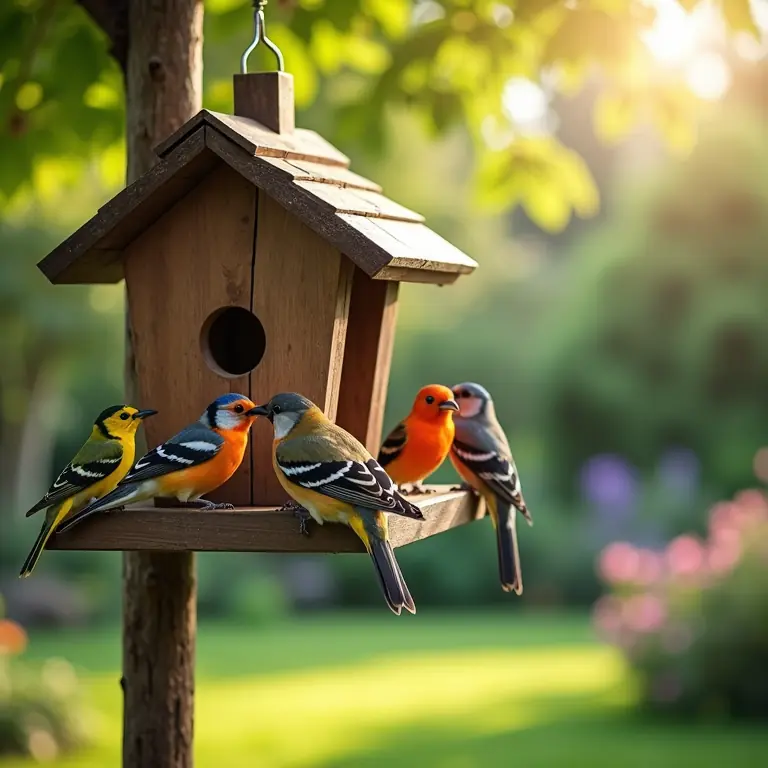Build a Backyard Bird Feeder: A Simple Guide to Welcoming Wildlife
Have you ever wanted to bring the beauty of nature a little closer to home? Building a bird feeder is a fantastic way to do just that! It’s a rewarding project that provides sustenance for local birds, offers endless entertainment, and adds a delightful charm to your backyard. This guide will walk you through everything you need to know, from choosing the right design to attracting a variety of feathered friends. We’ll cover materials, construction, placement, and maintenance, all with a friendly and educational approach. So, let’s get started!
Why Build a Bird Feeder?
Before we dive into the how-to, let’s appreciate the *why*. Bird feeders aren’t just about providing food; they contribute to a healthier ecosystem. Here’s a breakdown of the benefits:
- Supports Local Bird Populations: Birds rely on natural food sources like insects, seeds, and berries. During harsh weather or times of scarcity, feeders provide a vital lifeline.
- Enhances Your Connection with Nature: Observing birds is incredibly therapeutic. It’s a wonderful way to slow down, appreciate the small things, and connect with the natural world.
- Educational Opportunity: Bird feeders offer a unique opportunity to learn about different bird species, their behaviors, and their needs. It’s a great project for families, fostering a love for nature in children.
- Pollination & Pest Control: Many birds are also pollinators or help control garden pests. Attracting them to your yard can benefit your plants too!
- Simple Joy: Let’s be honest, watching birds flit around your feeder is simply enjoyable.
Choosing the Right Bird Feeder Design
There’s a bird feeder design to suit every preference and budget. Here are some popular options:
- Hopper Feeders: These are probably the most common type. They have a reservoir that holds a large amount of seed and dispenses it as birds eat. They’re good for a variety of birds.
- Tube Feeders: These are cylindrical feeders with perches. They’re excellent for smaller birds like finches and chickadees. Different port sizes can cater to different seed types.
- Platform Feeders: Simple, open platforms that attract a wide range of birds. They require more frequent cleaning as seeds can get wet and moldy.
- Suet Feeders: These hold suet, a high-fat food source that’s particularly beneficial for birds in the winter. Woodpeckers, nuthatches, and chickadees love suet.
- Nectar Feeders (Hummingbird Feeders): Designed specifically for hummingbirds, these feeders hold a sugar-water solution.
- DIY Feeders: You can get creative and build your own feeders from recycled materials like plastic bottles, milk cartons, or even pinecones!
For this guide, we’ll focus on building a simple hopper feeder, as it’s a great starting point for beginners. It’s relatively easy to construct and attracts a good variety of birds.
Materials You’ll Need
Here’s what you’ll need to build a basic hopper feeder:
- Wood: Approximately 1” x 6” untreated lumber (cedar or redwood are excellent choices due to their weather resistance). You’ll need about 6-8 feet depending on the size of your feeder. Avoid pressure-treated wood as it can be harmful to birds.
- Plywood: A small piece of plywood for the base (approximately 6” x 6”).
- Screws or Nails: Exterior-grade screws or nails are essential for durability.
- Wood Glue: Water-resistant wood glue will add extra strength to the joints.
- Saw: A hand saw, circular saw, or jigsaw will be needed to cut the wood.
- Drill: For pre-drilling holes and attaching screws.
- Sandpaper: To smooth rough edges.
- Measuring Tape & Pencil: For accurate measurements and marking.
- Hanging Hardware: Eye hooks, chain, or wire for hanging the feeder.
Step-by-Step Construction Guide
- Cut the Wood: Cut the lumber into the following pieces (these dimensions are approximate – adjust as desired):
- Two side pieces: 8” x 8” (these will form the sides of the hopper)
- Front piece: 6” x 8”
- Back piece: 10” x 8” (the extra height allows for easier filling)
- Bottom piece: 6” x 6” (plywood)
- Roof pieces (two): 7” x 9” (these will overhang the sides to protect the seed)
- Assemble the Sides: Apply wood glue to the edges of the bottom piece and attach the side pieces, securing them with screws or nails. Ensure the sides are perpendicular to the bottom.
- Attach the Front and Back: Glue and screw/nail the front and back pieces to the sides and bottom, creating the main hopper box.
- Create the Seed Dispensing Holes: On the front piece, drill two or three holes approximately 2” in diameter. These holes will allow the seed to dispense as birds eat.
- Attach the Roof: Angle the roof pieces slightly and attach them to the top of the side, front, and back pieces using glue and screws/nails. Ensure the roof overhangs the sides to provide protection from rain and snow.
- Sand the Edges: Use sandpaper to smooth any rough edges or splinters.
- Add Hanging Hardware: Drill small holes in the top corners of the back piece and screw in eye hooks. Attach a chain or wire to the eye hooks for hanging.
- Optional: Add Perches: You can add small dowels below the seed dispensing holes as perches for the birds.
Choosing the Right Bird Seed
The type of seed you offer will determine which birds you attract. Here’s a guide:
- Black Oil Sunflower Seeds: A favorite of many birds, including cardinals, chickadees, finches, and nuthatches. High in fat and protein.
- Striped Sunflower Seeds: Larger and harder to crack than black oil sunflower seeds. Preferred by larger birds like jays and grosbeaks.
- Nyjer (Thistle) Seed: Attracts finches, especially goldfinches. Requires a special feeder with small ports.
- White Proso Millet: A favorite of ground-feeding birds like doves and sparrows.
- Safflower Seed: Cardinals and chickadees love safflower seed, but squirrels often avoid it.
- Peanuts: Woodpeckers, nuthatches, and jays enjoy peanuts.
- Seed Mixes: Convenient, but often contain filler seeds that birds don’t prefer.
Experiment with different seed types to see what attracts the most birds to your feeder. Remember to store seed in a cool, dry place to prevent it from spoiling.

Placement is Key
Where you place your bird feeder can significantly impact its success. Consider these factors:
- Safety from Predators: Place the feeder in a location where birds have a clear view of their surroundings, allowing them to spot approaching predators like cats or hawks. Avoid placing it too close to shrubs or trees where predators can hide.
- Shelter from the Elements: A location sheltered from strong winds and direct sunlight is ideal.
- Accessibility for Cleaning: Choose a location that’s easily accessible for cleaning and refilling.
- Visibility: Place the feeder where you can easily enjoy watching the birds!
- Distance from Windows: To prevent birds from flying into windows, place the feeder either very close to the window (within 3 feet) or far away (more than 30 feet).
Maintenance and Cleaning
Regular maintenance is crucial for keeping your bird feeder healthy and safe for birds. Here’s what you need to do:
- Clean Regularly: Clean your feeder at least once every two weeks, or more often if it’s heavily used. Remove old seed, droppings, and debris.
- Use a Disinfectant: Wash the feeder with a mild soap and water solution, or a diluted bleach solution (1 part bleach to 9 parts water). Rinse thoroughly and allow to dry completely before refilling.
- Check for Mold: Inspect the feeder regularly for mold. Moldy seed can make birds sick.
- Repair as Needed: Inspect the feeder for any damage and repair it promptly.
- Ground Cleanup: Regularly sweep up spilled seed from the ground to prevent attracting rodents.
Attracting a Variety of Birds
Want to attract more than just a few common birds? Here are some tips:
- Offer a Variety of Seeds: Different birds prefer different seeds.
- Provide Water: A bird bath or shallow dish of water is a welcome addition to any backyard.
- Plant Native Plants: Native plants provide natural food sources and shelter for birds. Consider planting berry-producing shrubs and trees. You might enjoy learning more about growing your own herbs too – check out growing a kitchen herb garden!
- Provide Shelter: Trees and shrubs offer birds a safe place to perch and hide from predators.
- Avoid Pesticides: Pesticides can harm birds and their food sources.
- Keep Cats Indoors: Cats are a major threat to birds.
Troubleshooting Common Problems
- Squirrels: Squirrels can be a nuisance. Use a squirrel-resistant feeder, or place the feeder in a location that squirrels can’t reach.
- Large Birds Bullying Smaller Birds: Offer a variety of feeders, including some that are specifically designed for smaller birds.
- No Birds Visiting: Be patient! It may take a few weeks for birds to discover your feeder. Make sure you’re offering the right seeds and that the feeder is placed in a suitable location.
Further Exploration
Building a bird feeder is just the beginning! Here are some resources to continue your bird-watching journey:
- The Cornell Lab of Ornithology: https://www.birds.cornell.edu/
- Audubon Society: https://www.audubon.org/
Don’t forget to also explore other ways to connect with nature. Maybe you’d like to try your hand at botanical illustration or even declutter your digital life – it’s all about finding balance! See this guide on digital decluttering for more information.
Bringing nature into your backyard is a rewarding experience. With a little effort, you can create a haven for birds and enjoy the beauty of wildlife right outside your window. Happy building and happy bird watching!


Discussion about this post